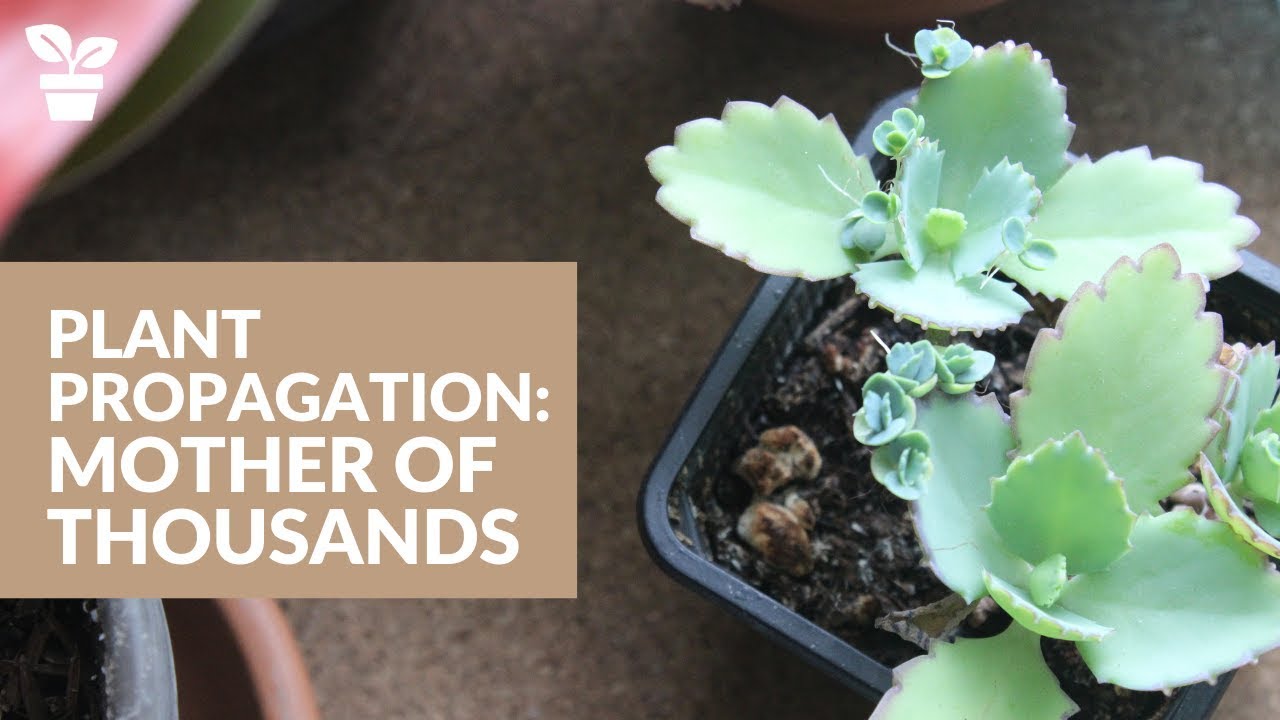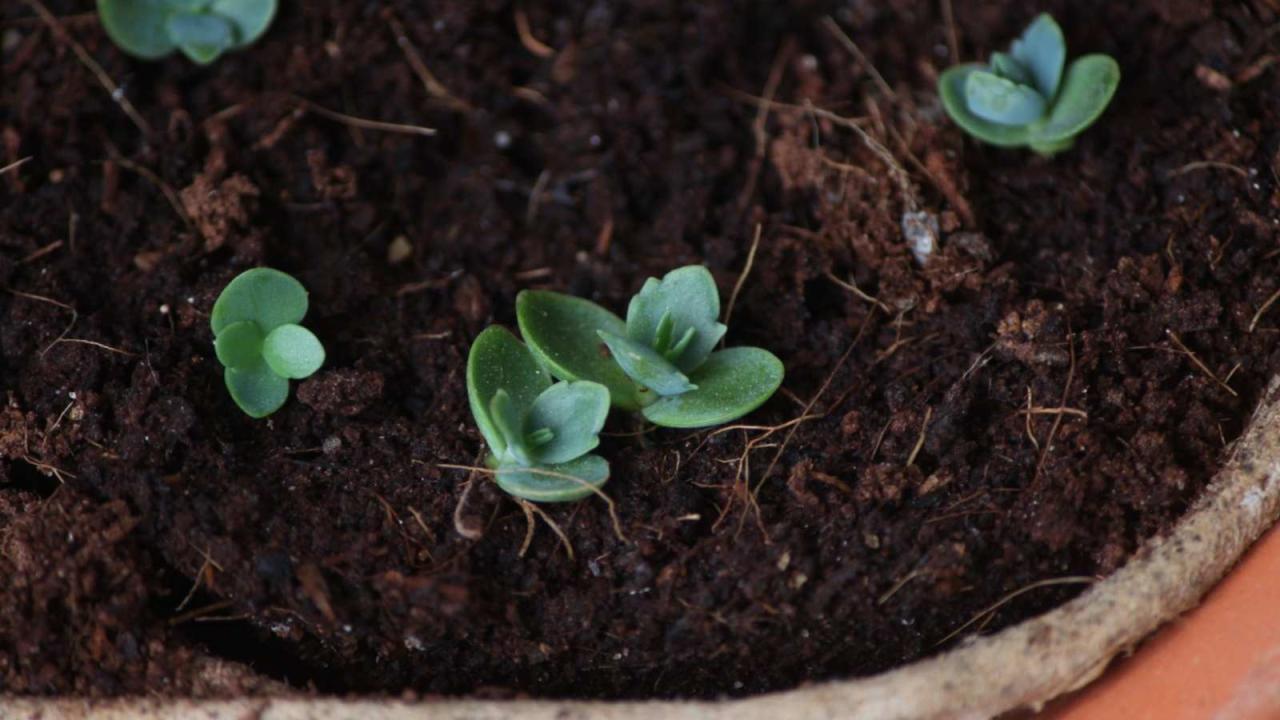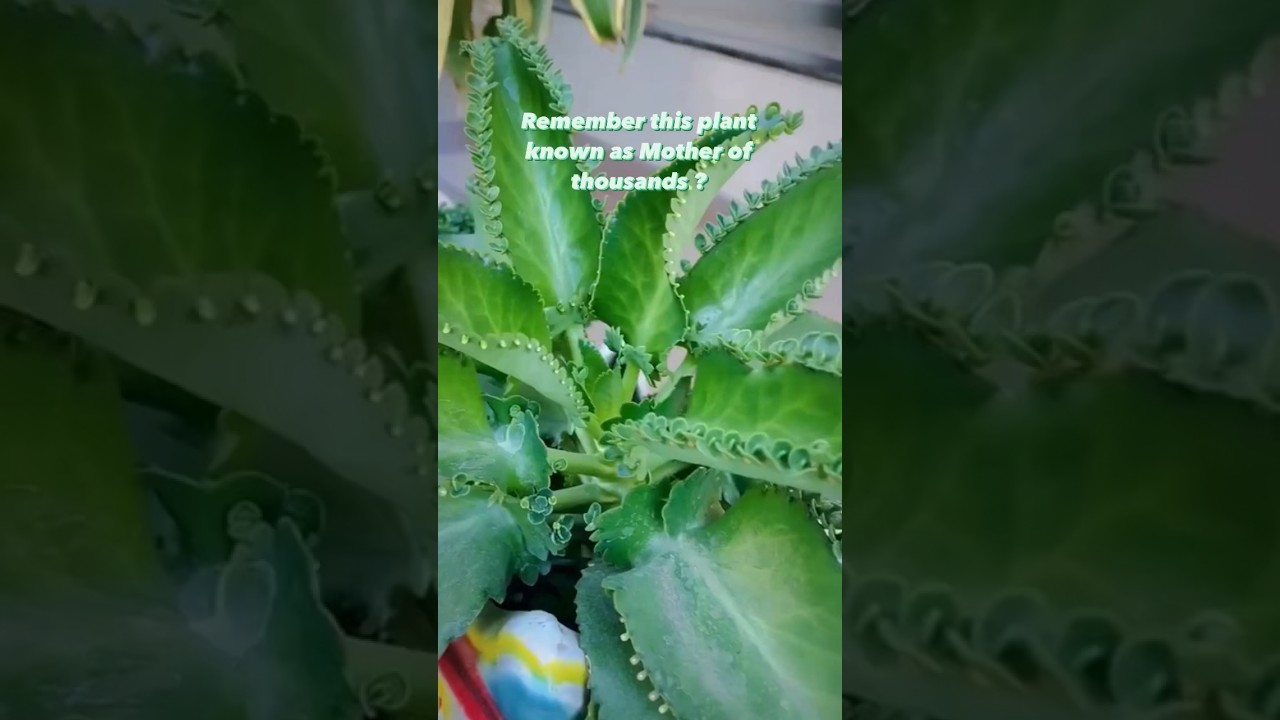Propagating Mother of Thousands: What You Need to Know for Success, is a captivating journey into the world of this unique plant. Known for its prolific nature and ease of propagation, the Mother of Thousands, or Kalanchoe daigremontiana, is a fascinating succulent that can quickly transform your home or garden.
This article delves into the fascinating world of Mother of Thousands, providing a comprehensive guide to its propagation, care, and potential challenges.
Native to Madagascar, the Mother of Thousands is a visually striking succulent that is prized for its distinctive leaves. These leaves are fleshy, lance-shaped, and often sport small plantlets along their edges, a characteristic that gives this species its common name.
With its adaptable nature and unique propagation methods, the Mother of Thousands is a popular choice for both novice and experienced gardeners.
Introduction to Mother of Thousands

The Mother of Thousands, a captivating succulent with its unique reproductive strategy, is a popular choice among plant enthusiasts. This article will delve into the fascinating world of this plant, exploring its origins, characteristics, and the secrets to successful propagation.
Botanical Name and Common Names
The Mother of Thousands, scientifically known as
- Kalanchoe daigremontiana*, is a member of the
- Crassulaceae* family. It is also commonly called
- Bryophyllum daigremontiana*,
- Mexican hat plant*, and
- Chandelier plant*. These names reflect its distinctive features and growth habits.
Understanding Propagation Methods
Propagating Mother of Thousands is a rewarding and straightforward process, primarily achievable through two methods: leaf cuttings and plantlets. These methods leverage the plant’s natural ability to reproduce asexually, allowing you to create new plants from existing ones.
Leaf Cuttings
Leaf cuttings offer a simple and efficient method for propagating Mother of Thousands. This technique involves taking a healthy leaf from the parent plant and allowing it to develop roots and new growth.
- Select a Healthy Leaf:Choose a mature, healthy leaf from the parent plant, free from any signs of disease or damage. Ensure the leaf is firm and not wilting.
- Prepare the Cutting:Gently remove the leaf from the parent plant, leaving a small portion of the stem attached. This stem portion contains the axillary buds that will eventually develop into new plants.
- Allow the Cutting to Dry:Place the leaf cutting in a dry, well-ventilated area for a few days to allow the cut end to callous over. This prevents rot and encourages root development.
- Planting the Cutting:Once the cutting has calloused, you can plant it in a suitable growing medium, such as a mixture of potting soil and perlite. Plant the cutting shallowly, ensuring that the stem portion is buried in the soil.
- Provide Optimal Conditions:Place the potted cutting in a bright location with indirect sunlight and maintain a warm, humid environment. Water the cutting regularly, keeping the soil moist but not waterlogged.
Within a few weeks, you should observe the development of tiny plantlets along the edges of the leaf cutting. These plantlets will eventually develop roots and can be separated from the parent leaf to become independent plants.
Propagating Mother of Thousands is a rewarding experience for plant enthusiasts, especially for those seeking a hands-on approach to plant reproduction. While this succulent thrives on its own, mastering the art of propagation can unlock even greater success. If you’re looking to explore the world of carnivorous plant propagation, How to Grow Venus Fly Traps From Seeds: Propagation Secrets Revealed offers valuable insights.
The techniques you’ll learn can be applied to a variety of plants, including Mother of Thousands, expanding your knowledge of plant cultivation and bringing you closer to the wonders of nature.
Plantlets
Mother of Thousands naturally produces tiny plantlets along the edges of its leaves. These plantlets are essentially miniature versions of the parent plant, complete with roots and the ability to grow independently.
- Identify Mature Plantlets:Look for plantlets that have developed a small root system. These plantlets will be ready to be separated from the parent plant.
- Gently Separate the Plantlet:Carefully detach the plantlet from the parent leaf, ensuring that the roots remain intact. A gentle tug or a sharp knife can be used for separation.
- Prepare a Planting Medium:Use a well-draining potting mix, such as a combination of potting soil, perlite, and vermiculite. The planting medium should be moist but not soggy.
- Plant the Plantlet:Gently insert the plantlet into the prepared potting mix, ensuring that the roots are spread out. Cover the base of the plantlet with soil, but do not bury the leaves.
- Provide Ideal Conditions:Place the potted plantlet in a bright location with indirect sunlight. Water the plantlet regularly, keeping the soil moist but not waterlogged.
The plantlet will continue to grow and develop, eventually forming a mature plant similar to the parent plant. This method offers a quick and effortless way to propagate Mother of Thousands.
Essential Growing Conditions
Providing Mother of Thousands with the right growing conditions is crucial for its health and propagation success. These conditions encompass the ideal soil type, adequate light exposure, and appropriate temperature range.
Soil Type and pH Level
The soil type plays a significant role in the growth of Mother of Thousands. It thrives in well-draining soil that prevents waterlogging, which can lead to root rot. A suitable soil mixture consists of a combination of:
- Potting soil
- Perlite
- Vermiculite
This blend ensures proper drainage and aeration, allowing roots to breathe and thrive. The ideal pH level for Mother of Thousands is slightly acidic to neutral, ranging from 6.0 to 7.0. This pH range promotes optimal nutrient absorption and growth.
Light Requirements
Mother of Thousands thrives in bright, indirect light. Direct sunlight can scorch its leaves, especially during the hottest part of the day. Ideally, place it near a window that receives ample sunlight but avoids direct exposure. Artificial light can also be used for successful growth.
Fluorescent or LED grow lights with a cool white spectrum, providing approximately 12-14 hours of light per day, are suitable options.
Temperature Range
Mother of Thousands prefers warm temperatures, ideally between 65°F and 80°F (18°C and 27°C). It can tolerate slightly cooler temperatures, but prolonged exposure to cold can hinder its growth. Avoid placing it in drafty areas or near cold windows.
Watering and Maintenance
Watering and maintenance play crucial roles in ensuring the health and vitality of your Mother of Thousands. By understanding the plant’s needs and implementing proper care techniques, you can create an optimal environment for its growth and propagation.
Watering Frequency and Techniques
The Mother of Thousands thrives in well-draining soil and prefers a slightly dry environment. Overwatering can lead to root rot, while underwatering can cause the leaves to wilt and become brittle.
- Watering Frequency:Water your Mother of Thousands thoroughly when the top inch of soil feels dry to the touch. This typically translates to watering once every 1-2 weeks during the growing season (spring and summer). During the winter months, reduce watering frequency to once every 2-4 weeks, as the plant enters a dormant period.
- Watering Techniques:When watering, ensure that the water reaches the entire root system. Avoid overwatering, as this can lead to root rot. Allow excess water to drain away from the pot to prevent waterlogging. You can use a watering can with a long spout to reach the roots, or you can soak the pot in a sink filled with water for a few minutes.
Propagating Mother of Thousands is a breeze thanks to its prolific plantlets, but for a carnivorous challenge, try propagating Venus Fly Traps. Learn how to successfully cultivate these fascinating plants from seed or leaf cuttings with our guide on Quick and Easy Venus Fly Trap Propagation You Can Try at Home.
Once you’ve mastered the art of propagating these unique plants, you’ll be well on your way to expanding your collection of both Mother of Thousands and Venus Fly Traps.
Signs of Overwatering and Underwatering
Recognizing the signs of overwatering and underwatering is essential for adjusting your watering practices.
- Overwatering:Signs of overwatering include yellowing leaves, wilting, and a mushy stem. The soil will also feel constantly damp or soggy. If you notice these signs, immediately reduce watering frequency and allow the soil to dry out completely before watering again.
- Underwatering:Signs of underwatering include dry, brittle leaves, and a wilting appearance. The soil will feel dry to the touch. If you notice these signs, water the plant thoroughly until water drains out of the drainage holes.
Essential Maintenance Practices, Propagating Mother of Thousands: What You Need to Know for Success
Regular maintenance practices, such as fertilizing, pruning, and pest control, are essential for maintaining the health and vigor of your Mother of Thousands.
Fertilizing
Fertilizing your Mother of Thousands during the growing season can promote healthy growth and lush foliage.
- Frequency:Fertilize your Mother of Thousands once a month during the growing season (spring and summer) using a balanced liquid fertilizer diluted to half strength. Avoid overfertilizing, as this can burn the roots.
- Type of Fertilizer:Use a balanced liquid fertilizer with a ratio of 10-10-10 or 20-20-20. Avoid using fertilizers with a high phosphorus content, as this can inhibit growth.
Pruning
Pruning your Mother of Thousands is not strictly necessary but can help maintain its shape and encourage bushier growth.
- Frequency:Prune your Mother of Thousands as needed to remove any dead, damaged, or overcrowded leaves.
- Technique:Use sharp, clean pruning shears to remove the desired leaves. Cut just above a node, which is the point where a leaf grows from the stem.
Pest Control
The Mother of Thousands is generally resistant to pests. However, it is still important to be aware of potential threats and take preventative measures.
- Common Pests:Common pests that can affect Mother of Thousands include aphids, mealybugs, and spider mites.
- Prevention:Regularly inspect your plant for signs of pests, such as sticky residue, webbing, or small insects.
- Control:If you notice pests, treat them with insecticidal soap or neem oil.
Potential Challenges and Solutions

While Mother of Thousands is generally easy to propagate, there are some common challenges that may arise. Understanding these issues and implementing appropriate solutions can ensure successful propagation and healthy plant growth.
Root Rot and Fungal Infections
Root rot and fungal infections are common problems in succulent propagation. These issues occur when the soil is overly wet, creating an environment conducive to fungal growth.
- Overwatering: Excessive watering leads to waterlogged soil, depriving roots of oxygen and promoting fungal growth.
- Poor Drainage: Inadequate drainage in the propagation medium can trap water, leading to root rot.
- Infected Medium: Using contaminated soil or propagation mix can introduce fungal spores.
Troubleshooting
- Repotting: If root rot is suspected, remove the plant from the propagation medium, inspect the roots, and remove any rotted portions. Repot in fresh, well-draining soil.
- Fungicide Treatment: Applying a fungicide can help control fungal infections.
- Adjust Watering Practices: Allow the soil to dry completely between waterings to prevent waterlogging.
Prevention
- Use a Well-Draining Medium: A mix of cactus potting soil, perlite, and vermiculite provides excellent drainage.
- Sterilize Propagation Medium: Heat the propagation medium in the oven at 200°F for 30 minutes to kill any fungal spores.
- Choose Healthy Leaf Cuttings: Select healthy, disease-free leaf cuttings for propagation.
Slow or Stunted Growth
While Mother of Thousands is known for its fast growth, slow or stunted growth can occur due to various factors.
- Insufficient Light: Mother of Thousands thrives in bright, indirect light. Insufficient light can lead to elongated growth and pale leaves.
- Nutrient Deficiency: Lack of essential nutrients, particularly nitrogen, can hinder growth.
- Overcrowding: Crowded conditions can restrict access to light and nutrients, impacting growth.
Troubleshooting
- Increase Light Exposure: Move the plant to a brighter location, ensuring it receives at least six hours of indirect sunlight daily.
- Fertilize Regularly: Use a balanced succulent fertilizer diluted to half strength every few weeks during the growing season.
- Repot to a Larger Container: If the plant is root-bound, repot it into a larger container with fresh potting mix.
Prevention
- Provide Adequate Light: Choose a sunny location for propagation and ensure the plant receives ample light.
- Use Nutrient-Rich Soil: Select a well-draining potting mix specifically formulated for succulents.
- Monitor Plant Growth: Regularly check for signs of overcrowding and repot as needed.
Mother of Thousands in Different Environments

Mother of Thousands, with its captivating appearance and effortless propagation, is a popular choice for both indoor and outdoor cultivation. Understanding the plant’s preferences and adaptability across various environments is crucial for successful growth. This section will delve into the suitability of Mother of Thousands for different growing spaces, including container gardening and hanging baskets, while also addressing its potential for invasiveness in specific regions.
Mother of Thousands in Indoor Environments
Mother of Thousands thrives in indoor environments, particularly in well-lit areas with indirect sunlight. The plant prefers temperatures between 65°F and 75°F (18°C and 24°C) and humidity levels above 40%. It is essential to choose a pot with drainage holes to prevent waterlogging, which can lead to root rot.
- Ideal Location:A sunny windowsill or a location with bright, indirect light is suitable. Avoid direct sunlight, which can scorch the leaves.
- Watering:Allow the soil to dry slightly between waterings, ensuring that the plant doesn’t sit in water. Overwatering can be detrimental to its health.
- Humidity:Mother of Thousands benefits from increased humidity, which can be achieved by grouping plants together or placing a humidifier nearby.
- Potting Mix:Use a well-draining potting mix that is specifically formulated for succulents or cacti.
Mother of Thousands in Outdoor Environments
While Mother of Thousands can tolerate outdoor conditions, it is crucial to consider the climate and potential for invasiveness. In temperate regions with mild winters, it can thrive outdoors in well-drained soil. However, in areas with frost or extreme temperatures, it’s best to cultivate it indoors or in a protected outdoor space.
- Suitable Climate:Mother of Thousands thrives in USDA hardiness zones 9-11, where temperatures rarely drop below freezing.
- Sunlight:The plant prefers partial shade to full sun, avoiding direct sunlight during the hottest hours of the day.
- Soil:Well-drained soil with a slightly acidic to neutral pH is ideal. Avoid planting in heavy clay soil, which can retain too much moisture.
Mother of Thousands in Container Gardening
Container gardening offers flexibility and control over the growing environment. Mother of Thousands is well-suited for container cultivation, allowing for easy relocation and protection from harsh weather conditions.
- Container Choice:Select a pot with drainage holes and a size that allows for adequate root growth. Terracotta pots are a popular choice for succulents due to their porous nature, which helps regulate moisture levels.
- Potting Mix:Use a well-draining potting mix specifically designed for succulents or cacti. Avoid using regular potting soil, which can retain too much moisture.
- Location:Place the container in a location that receives bright, indirect light. Avoid direct sunlight during the hottest hours of the day, especially in hot climates.
Mother of Thousands in Hanging Baskets
Mother of Thousands’ cascading growth habit makes it an excellent choice for hanging baskets. The trailing stems create a beautiful display and add a touch of greenery to any space.
- Basket Selection:Choose a basket with drainage holes and a sturdy structure to support the weight of the plant as it grows. Baskets made from materials like wicker or metal are popular choices.
- Potting Mix:Use a well-draining potting mix specifically designed for succulents or cacti. Avoid using regular potting soil, which can retain too much moisture.
- Location:Hang the basket in a location that receives bright, indirect light. Avoid direct sunlight during the hottest hours of the day, especially in hot climates.
Potential for Invasiveness
While Mother of Thousands is a delightful plant, it’s important to be aware of its potential for invasiveness in certain regions. The plant readily reproduces through its plantlets, which can easily detach and take root in suitable environments.
- Regions of Concern:In areas with warm, humid climates, Mother of Thousands can become invasive, outcompeting native vegetation and disrupting ecosystems.
- Control Measures:To prevent the plant from becoming invasive, it’s essential to remove plantlets promptly and avoid planting it in areas where it can spread unchecked.
- Alternatives:Consider alternative plants with similar characteristics but less invasive tendencies, such as other succulents or trailing plants.
Final Review: Propagating Mother Of Thousands: What You Need To Know For Success
Whether you are an experienced gardener or a curious beginner, propagating Mother of Thousands is an exciting and rewarding experience. By understanding the fundamentals of leaf cuttings, plantlet propagation, and providing the optimal growing conditions, you can successfully cultivate this captivating succulent.
Remember to address any potential challenges with patience and proper care, and enjoy the rewarding journey of nurturing your very own Mother of Thousands. As you witness the plant’s prolific growth and distinctive features, you will truly appreciate the fascinating world of succulents and the joy of propagation.
FAQ Resource
Is Mother of Thousands toxic to pets?
Yes, Mother of Thousands is toxic to pets, especially cats and dogs. Ingestion can cause gastrointestinal upset and other health issues. Keep the plant out of reach of pets.
How often should I fertilize my Mother of Thousands?
Fertilize your Mother of Thousands during the growing season (spring and summer) with a balanced liquid fertilizer diluted to half strength. Fertilize every 4-6 weeks.
Can I propagate Mother of Thousands from seeds?
While possible, propagating Mother of Thousands from seeds is less common than using leaf cuttings or plantlets. Seeds can be sown in a seed starting mix and kept moist.
